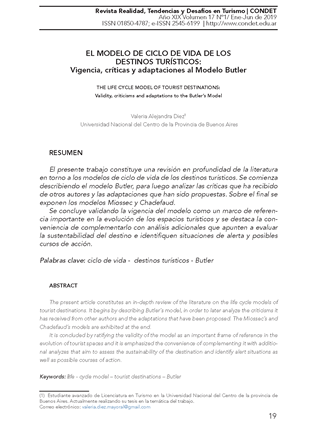El modelo de ciclo de vida de los destinos turísticos: vigencia, críticas y adaptaciones al modelo Butler.
Contenido principal del artículo
Resumen
Se concluye validando la vigencia del modelo como un marco de referencia importante en la evolución de los espacios turísticos y se destaca la conveniencia de complementarlo con análisis adicionales que apunten a evaluar la sustentabilidad del destino e identifiquen situaciones de alerta y posibles cursos de acción.
Descargas
Detalles del artículo
Citas
Agarwal, S. (1994). The Resort Cycle Revisited: Implications for Resorts. In Progress in Tourism, Recreation and Hospitality Management, 5, 194-208.
Agarwal, S. (1997). The Resort Cycle and Seaside Tourism: An Assessment of its Applicability and Validity. Tourism Management, 18(2), 65-73.
Agarwal, S. (2006). Coastal resort restructuring and the TALC. in: R.W. Butler (Ed.), The Tourism Area Life Cycle: Conceptual and Theoretical Issues, Channelview
Álvarez Alonso, A. (2004). El ciclo de vida de los destinos turísticos litorales. Turismo y territorio en la ciudad globalizada, 123-155.
Berry, T. (2006). The predictive potential of the TALC model, in: R.W. Butler (Ed.), The Tourism Area Life Cycle: Conceptual and Theoretical Issues, Channelview Publications,Clevedon, 254–280
Butler, R. W. (1980). The Concept of a Tourist Area Cycle of Evolution: Implications for Management of Resources. Canadian Geographer, 24(1), 5-12.
Butler, R. W. (2006). The future and the TALC. The tourism area life cycle: Conceptual and Theoretical Issues, Channelview Publications, Clevedon. 2, 281-290.
Butler, R. W. (2011). Tourism area life cycle. Contemporary Tourism Reviews series. 1-33
Cáceres, E., y Rodríguez, J. (2002). Génesis y desarrollo del espacio turístico en Canarias: una hipotésis de trabajo. Universidad de Las Palmas de Gran Canaria; Gobierno de Canarias, Consejería de Educación, Cultura y Deportes, Consejería de Turismo y Transportes.
Chadefaud, M. (1987). Aux origines du tourisme dans les pays de l’Adour, du mythe à l’espace: un essai de géographie historique. Département de Géographie et d´épartement de Géographie et.
Cooper, C. (1994). The Destination Life Cycle: an Update. Tourism. The State of the Art. 340-346.
Cooper, C., y Jackson, S. (1989). Destination life cycle: The Isle of Man case study. Annals of tourism research, 16(3), 377-398.
Diedrich, A., y García Buades, E. (2009). Local perceptions of tourism as indicators of destination decline. Tourism Management, 30(4), 512-521.
Donaire, J.A., y Mundet, L (2001). “Estrategias de reconversión turística de los municipios litorales catalanes”. Papers de Turisme, 29: 55-65
Getz, D. (1992). Tourism planning and destination life cycle. Annals of tourism research, 19(4), 752-770.
González, P. (2015). Crisis y renovación en el ciclo de vida de los destinos turísticos. El caso de Puerto de la Cruz, Tenerife. Atlántida, 6, 101-122.
Haywood, M. (1986). Can the Tourist-Area Cycle of Evolution be Made Operational? Tourism Management, 7, 154-167.
Hovinen, G. (1981). A tourist cycle in Lancaster County, Pennsylvania. The Canadian Geographer/Le Géographe canadien, 25(3), 283-286.
Hovinen, G. (2002). Revisiting the destination life cyce model. Annals of Tourism Research, 29(1), 209-230.
Johnston, C. (2001). Shoring the Foundations of the Destination Life Cycle Model, Part 1: Ontological and Epistemological Considerations. Tourism Geographies, 3(1),
Knowles, T. y S. Curtis (1999). The Market Viability of European Mass Tourist Destinations. A Post-Stagnation Life-Cycle Analysis. International Journal of Tourism Research, 1 (2), 87-96.
López Guevara, M. V. (2011). La reorientación del ciclo de vida del área turística: el caso de Bahías de Huatulco, Oaxaca (México). Universidad de Alicante. Investigaciones Turísticas, 1-158.
Miossec, J. (1977). Un Modéle de L’Espace Touristique. L’Espace Géographique, 6(1), 41-48.
Moore, W., y Whitehall, P. (2005). The tourism area lifecycle and regime switching models. Annals of Tourism Research, 32(1), 112-126.
Naranjo, L., Rodríguez, R., y Rodríguez, O. (2018). El ciclo de vida del producto turístico. Trinidad de Cuba como caso de estudio. ReHuSo: Revista de Ciencias
Humanísticas y Sociales. 3(2), 1-12.
Plog, S. C. (1974). Why destination areas rise and fall in popularity. Cornell hotel and restaurant administration quarterly, 14(4), 55-58.
Priestley, G., y Mundet, L. (1998). The post-stagnation phase of the resort cycle. Annals of Tourism Research, 25(1), 85–111.
Rodríguez González, P. (2015). Crisis y renovación en el ciclo de vida de los destinos turísticos. El caso de Puerto de la Cruz, Tenerife. Revista Canaria de Ciencias Sociales. N°6, 101-122.
Rodríguez Jiménez, G. (2016). Determinación de la fase del ciclo de vida del destino turístico regional Villa Clara y de los factores influyentes en su estrategia de crecimiento. Universidad Central Marta Abreu de la Villas.
Soares, J., y Gandara, J. (2010). La evolución de los destinos turísticos litorales consolidados y estrategias para su renovación: un análisis de Florianópolis. 13° Congreso Internacional de Turismo. Universidad y Empresa, 113-136.
Valdés, A., Martínez, E., y Nechar, M. (2017). Origen, concepción y tratamiento del ciclo de vida de los destinos turísticos: una reflexión en torno al modelo de
Butler. Revista Científica Compendium, 20(38).
Vera Rebollo, J. (1997). Análisis territorial del turismo. Una nueva geografía del turismo. Madrid. Ariel.
Virgen Aguilar, C. R. (2009). El Ciclo De Vida de un Destino Turístico: Puerto Vallarta, Jalisco, México. CULTUR – Revista de Cultura e Turismo (1).1-24.
